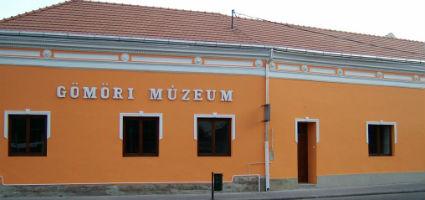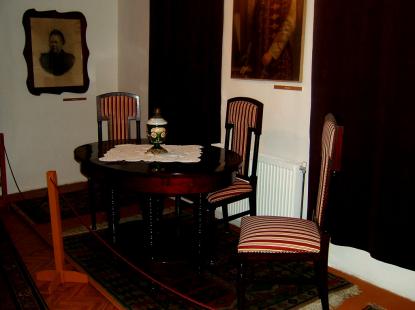2024. November 21. Thursday
Gömör Museum - Putnok
 |
Address: 3630, Putnok Serényi László tér 10
Phone number: (48) 430-292
E-mail: gomorimuz@gmail.com
Opening hours: *Mon-Fri 8.00-16.00, Sat 10.00-14.00
|
Museum tickets, service costs:
|
Ticket for adults
|
400 HUF
|
|
|
Ticket for students
|
200 HUF
|
|
|
Ticket for pensioners
|
200 HUF
|
Hungarians settled in the Árpád Age in the valleys in Gömör county situated between the Gömör-Szepesi Hills and the Bükk. In the 14-15th centuries, the number of Slovakian population grew in the North while Germans arrived to the mining towns. The Huszita wars, the Turkish subjection and the Thököly-Rákóczy War of Independence halted development in the region. The region began to recover around the middle of the 18th century. Mining and iron manufacturing developed faster.

Towards the end of the 19th century, Gömör, along with Kishont, was the most industrialized county in Hungary. Almost all fields of small businesses flourished, as well as animal husbandry and commerce based on them. The road connecting Upper Hungary, Transylvania and the Plains led through the Valley of Sajó. It was among the most important commercial roads. Where farming was impossible, forestry was significant.
After the Trianon Treaty, of 281 habitats in the county only 21 was attached to Hungary. Thus, Gömör, as an independent county seized to exist. However, the region populated by Hungarian speaking people is still considered as an independent region by researchers due to similar social circumstances and cultural heritage.
A map of Putnok is displayed on one of the walls of the first ward. We also show old postcards of Putnok borrowed from the private collection of Győző Rácz. The other section introduces the Serényi family that lived in Putnok via photos, paintings and furniture the museum received as present in 2005.
Following this section, a greater unit shows ceramics made in Putnik, a carpenter made chest, fibre made in Putnok, as well as tools of weaving. The first documents considering potters working in Putnok is from the 16th century. In the towns of the region, Rimaszombat, Jolsva, Szepsi, Rozsnyó independent potter guilds were established in the 17th century. The most widely used product of potters was a pot with narrow bottom and round inside. It was called the 'Tót pot' in the Plains.
A separate ward shows puppets made by the puppet artist Mrs Tóth, Ilus Horányi. She was the master of folk art, heroes of fairy tales and a fairy playing with puppets. 'They are like my children' she kept saying about the puppets. And indeed. These wonderful beings were born under her hands and they beamed with beauty and faith. The other side of the room holds painted eggs by the artist Mrs. Hárskuti from Ragály. Aunt Erzsike learned how to paint eggs from her mother. She loved painting flowers while her mother preferred old patterns made up of narrowing lines, leafs, double hearts, flowers, sunflowers and the Sun.
The last room presents the interior of a civic home, with three chairs given to us by György Fazekas Jr.

Towards the end of the 19th century, Gömör, along with Kishont, was the most industrialized county in Hungary. Almost all fields of small businesses flourished, as well as animal husbandry and commerce based on them. The road connecting Upper Hungary, Transylvania and the Plains led through the Valley of Sajó. It was among the most important commercial roads. Where farming was impossible, forestry was significant.
After the Trianon Treaty, of 281 habitats in the county only 21 was attached to Hungary. Thus, Gömör, as an independent county seized to exist. However, the region populated by Hungarian speaking people is still considered as an independent region by researchers due to similar social circumstances and cultural heritage.
A map of Putnok is displayed on one of the walls of the first ward. We also show old postcards of Putnok borrowed from the private collection of Győző Rácz. The other section introduces the Serényi family that lived in Putnok via photos, paintings and furniture the museum received as present in 2005.
Following this section, a greater unit shows ceramics made in Putnik, a carpenter made chest, fibre made in Putnok, as well as tools of weaving. The first documents considering potters working in Putnok is from the 16th century. In the towns of the region, Rimaszombat, Jolsva, Szepsi, Rozsnyó independent potter guilds were established in the 17th century. The most widely used product of potters was a pot with narrow bottom and round inside. It was called the 'Tót pot' in the Plains.
A separate ward shows puppets made by the puppet artist Mrs Tóth, Ilus Horányi. She was the master of folk art, heroes of fairy tales and a fairy playing with puppets. 'They are like my children' she kept saying about the puppets. And indeed. These wonderful beings were born under her hands and they beamed with beauty and faith. The other side of the room holds painted eggs by the artist Mrs. Hárskuti from Ragály. Aunt Erzsike learned how to paint eggs from her mother. She loved painting flowers while her mother preferred old patterns made up of narrowing lines, leafs, double hearts, flowers, sunflowers and the Sun.
The last room presents the interior of a civic home, with three chairs given to us by György Fazekas Jr.
|
Related activities
|
|
